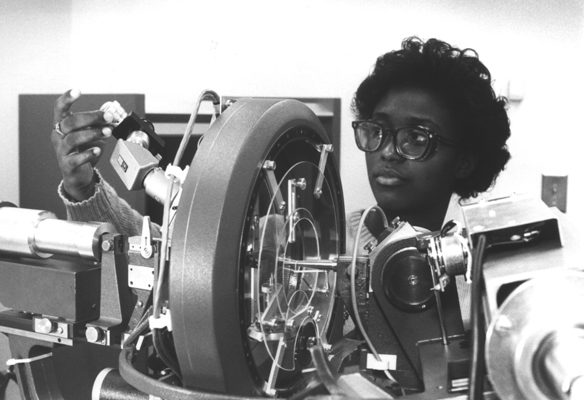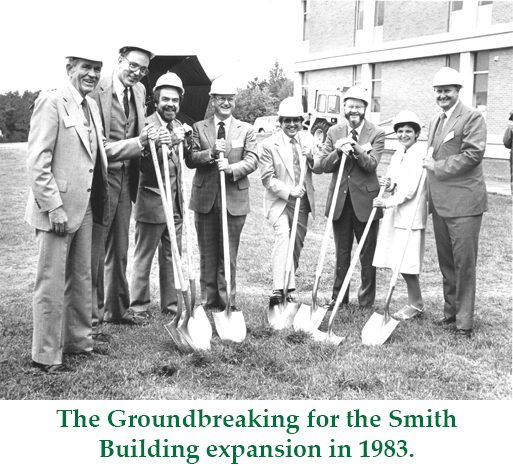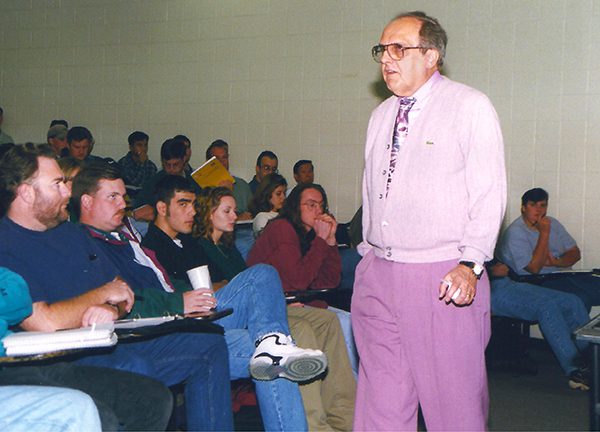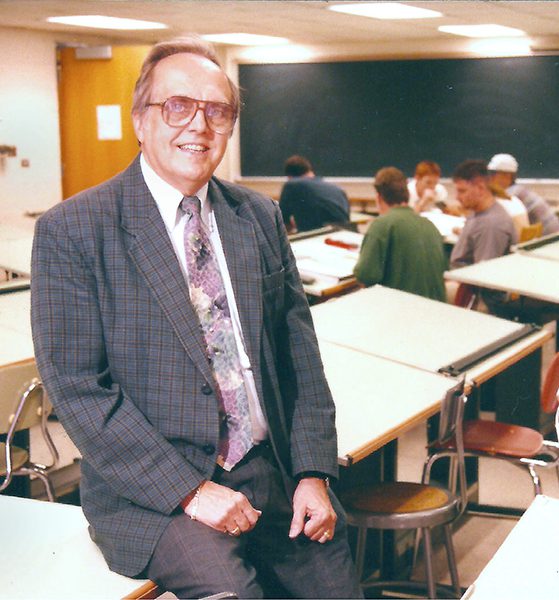Establishing 1977-1982
Bob Snyder came to UNC Charlotte in 1975 as chair of the Engineering Science, Mechanics and Materials Department. In 1976, Newton Barnette decided to step down as dean.

“He (Barnette) called me into his office, said he wanted to retire as dean and was recommending me as his replacement,” Snyder said. “I was floored, really floored. We then went to see Chancellor Colvard and Barnette told him that I was his choice for dean. Colvard didn’t seem surprised and told me the reason they had initially hired me was because they thought I could be dean. They had never told me that.”
Colvard appointed Snyder to a one-year term as dean. There was never an open search to consider other candidates, though, and after a year Snyder was made permanent dean. “They had circumvented the faculty in not doing a search,” Snyder said, “and took a lot of flack for it. I remember going into the first faculty meeting where it was announced that I was the new dean. The silence was deafening.”
Program Changes
From its initial enrollment of about 100 students in 1965, the College of Engineering had grown to more than 1,000 students in 1978. To meet the needs of this growing student population and to keep up with the rapidly advancing world of engineering, the faculty continuously updated and revised the academic programs and requirements.
“Curriculum had always evolved and been revised,” Evett said. “There was always pressure to get new things included. New technology came along and you had to take it into account. Engineering became more global and you had to include that perspective. Everyone thought we need more of this and more of that. And we did try to squeeze in more of everything.”
The continuous addition of courses led to undergraduate academic programs that required up to 150 credit hours for graduation.

“The engineering programs were long, tough and hard to finish in four years,” Evett said. “And the State of North Carolina was putting pressure on us to get our students out in four years. It was at this time that we limited programs to 128 credit hours.”
Changing along with the number of credit hours in 1980, were the names of the programs themselves.
“I think the original department names were chosen to intentionally be different,” Evett said. “They made it look like we had new, innovative programs. But we had trouble selling these programs, even to our own advisory board members and, more importantly, to the people hiring our students. The names got to be liabilities. Our grads wanted to be able to say ‘I’m a civil engineer’ or ‘I’m a mechanical engineer.’ The original names were a good idea, but they didn’t work.”
The original department names even created a good bit of extra work for faculty. “We had to write individual letters for our students to their potential employers and to graduate schools,” Bayer said, “explaining that these were real engineering programs and outlining what the curriculum was and what the students had studied.”
The accreditation board of the time had also decided to try and eliminate a lot of the engineering programs that had sprung up around country. “They wanted to limit the number of engineering programs and go back to the basics of electrical, mechanical and civil engineering,” Snyder said. “We said ‘Let’s not fight city hall,’ and we moved back to electrical, mechanical and civil.”
So, officially in 1981, Engineering Analysis and Design became Electrical Engineering, Urban and Environmental Engineering became Civil Engineering, and Engineering Science, Mechanics and Materials became Mechanical Engineering.
Smith Building Expansion
The Smith Building was filled with students, faculty and staff from numerous programs, but what it didn’t have throughout the 1970s was adequate laboratory equipment and facilities.
“We actually had a shaky accreditation about 1980, because we didn’t have good lab facilities,” Snyder said. “The accreditors passed us, but said we needed to be better funded by the state.”
The UNC General Administration responded to the need, allocating $250,000 over five years to the college for laboratory upgrades. “That was the first real chunk of money we got for our labs,” Snyder said.

More good news came for the Smith Building and the engineering program in 1981, when the state, university and college began discussing funding strategies to expand the building. To complete a planned 20,000 square-foot, $600,000 expansion, the General Administration agreed to pay half if UNC Charlotte could raise the other half from local industry.
“Our advisory council tried to help,” Snyder said, “but it couldn’t get it done. I had the $250,000 we needed in my foundation, but it didn’t want to spend it because I used the interest off that money to fund a number of other programs. I knew where the bread was butter, though, and Business Affairs handled the money for the UNC Charlotte Foundation. I told them ‘Please put up the money for this $250,000,’ and that I had money I could back it up with as collateral. So they put up the $250,000 to do the building. Then every year they’d come back to me say ‘When are you going to pay back the $250,000?’ Every year I’d say ‘Next year, I’m working with my advisory council on it.’ I never could seem to come up with the money. When a new guy took over in Business Affairs, though, he saw this $250,000 debit and said ‘Where’s that money Bob?’ I said ‘I don’t know,’ but I did know. So, at that point I had to pay the bill and they wiped out my $250,000 I had saved up as a safety net.”
The annex was a very important event for the college, adding 50 percent more space to the building. The new space made possible the addition of new classrooms, lecture halls, and structures, transportation and soils laboratories.
“For the first time, when we got the annex, we finally had a little bit of room for faculty to do research,” Snyder said. “Up until that time research laboratories were nonexistent. That was the first time we had some breathing room. That was the start of the research program.”
Snyder was building relationships with area engineering companies at the time to determine the type of research and graduate degree programs they needed to make their businesses successful. He was also looking to them for money to support the college of engineering.
“I was trying to make our programs as compatible as possible with the desires of practicing engineers who wanted advanced degrees, advanced training, continuing education and all that sort of stuff,” Snyder said. “I was trying to get money from Duke and other companies to help back our programs. I used any kind of leverage I could to get money or anything else I could get. I was taking advantage of any kind of opening I could find to make things happened. A lot of that stuff isn’t documented, but that’s how it was done.”

Bob Snyder
Born on April 15, 1934, Robert Snyder was one of the more colorful characters in the history of the College of Engineering. Although, perhaps, he wasn’t as colorful as the outfits he typically wore.
“Synder had 42 cardigan sweaters of various colors,” said Penny Bovender, Snyder’s long-time administrative assistant. “He used to plan his outfits a week in advance and write them all down in his day planner.”
The cardigans were various pastel colors and were used to tie his outfits together. His socks, pants and sweaters were of matching greens, pinks, purples and yellows. His shirts were usually a contrasting color, and were adorned with his crowning touch – a Looney Tunes tie featuring Bugs Bunny, Yosemite Sam, Daffy Duck or some other cartoon character.
“One of his most cherished awards was from Tau Beta Pi,” Bayer said, “for his ‘dress code’.”
Snyder earned his Ph.D. from West Virginia University in 1964, and then taught there as a professor of Theoretical and Applied Mechanics. In 1975, he came to UNC Charlotte as chair of the Engineering Science, Mechanics and Materials Department.
“I loved to teach and had been writing textbooks, that was my bag,” Snyder said. “I’m proud to be able to say today that I taught classes throughout my career. I was in front of students until the last year before I retired. It was the best part of every day.”
As an administrator, Snyder always put the students first. He realized that for the college to grow and compete for dollars it had to build strong research programs, but never at the expense of the undergraduate students.
“You don’t have to sacrifice one for the other,” Snyder said. “And the best researchers are almost always the best teachers. Bob Hocken was a great example of that. But it wasn’t always the other way around.”
Snyder understood what was important to the students and always stood up for them. He built programs that would lead them to successful engineering careers and also fought against every tuition increase.
“My door was always open to students,” he said. “I expected them to be professional when they came in, have their say and have a solution to propose. I taught then that for every action there is an equal and opposite reaction. That’s true in thermodynamics and true in life.”
Two qualities Snyder valued in himself and others were integrity and humor. “Integrity – where everyone could trust each other,” he said. “Always, if I gave you my word and said I would do something, I would do it. I wanted people to trust me. The second thing was humor. You have to find something to laugh at.”
An example of Snyder’s sense of humor was when he served as interim provost of UNC Charlotte for a time. Part of his job had been to clean house and he fired several deans. When he entered the faculty convocation that year, he had a big cigar in his mouth and hard hat on his head. “It was effort to diffuse tension with humor,” he said. “Everyone broke out in a laugh, so I guess it worked.”
Snyder was also famous for the picnics, cookouts and parties he held at his house and on campus for faculty and staff. “It was important to building the atmosphere of trust,” he said. “I felt it was particularly important to show the secretaries and technicians, who were not very well paid, that they were extremely valuable to us and important parts of the college. And we had a lot of fun at the parties.”
Electrical Engineering Professor and former Department Chairman Farid Tranjan remembers Snyder’s parties well. “He made sure everyone had a good time,” Tranjan said. “I remember a cookout at Snyder’s when he said we obligated to have fun, because ‘the pig gave his life for this party.’”
Tranjan got to know Snyder and his personality even better on a trip to Europe they went on together to establish exchange programs. “Snyder had always been somewhat reserved,” Tranjan said. “But from the culture of places like Spain, where you eat lunch from 2 to 7 and then get invited to dinner on the beach at 9, we discovered he had a real sense of humor.”
Snyder was a visionary who could see things coming five years away, and started working to get the resources needed to be ready and take advantage of the future, Tranjan said. “I loved working with Snyder. He was a no nonsense man. If he wanted something done he told you and you respected that. You knew where you stood with him. And if you needed his support and you were in the right, he would support you all the way to the top.”
The following are quotes and comments from other colleagues about Bob Snyder:
Norm Schul – “I spent either two or three years with him as a fellow dean. He was a big supporter of mine and I supported engineering. What I liked about Bob is that when we gave presentations they were well organized, well thought out and they were convincing. He knew what he wanted and he was going to get it if at all possible.
“Bob was futuristic and when you’re futuristic you ruffle feathers. I ruffled feathers and he ruffled feathers. He was very successful for what he did as dean. I give him full credit for that.”
Renda Gwalty, Snyder’s budget and finance assistant for many years – “When I first met Bob I told him I was the kind of person who liked to stay busy and needed something to do. Boy did I regret that.
“His ability with money was incredible. He knew the system so well. At year end he was ready with prepared lists of items to buy if there happened to be extra money. We got a lot of that money when others didn’t, because he was ready and they weren’t. He had the respect of everyone.”
Rick Lejk, Computer Science Department professor – “I had come out of the military into academia, and Snyder kept asking me why if I had a Ph.D. I didn’t have any research. I kept trying to explain to him that in the military you don’t do that. We sort of got off on the wrong foot.
“Eventually he saw me in a different light, and I became associate chair of computer science. Bob Snyder was a perfect person to work with. The guy was fantastic. I always told him he had so many pockets in his pants that he could grab money from. The way he and Renda operated together was unbelievable. They were a great team.”
Penny Bovender – “We thought Snyder was kind of kookey at first. We were all together for 20 years, though, and we got to really know him. He had a heart for his staff that a lot of people didn’t see. On the spur of moment he would have a staff luncheon and he gave us his personal credit card to pay for everything. And he still takes myself and Renda to lunch now that we’re all retired.”
Bob Johnson, dean of Lee College of Engineering starting in 2000 – “Bob Snyder is an interesting guy by any measure. I enjoyed working with him. He was very talented, very organized, and really appreciated continuous improvement efforts that are now mainstream. I think Bob really was ahead of his time in a lot of ways. I give him a lot of credit for getting this place where it is today.”
When Johnson took over from Snyder as dean of the college, he was amazed at his predecessor’s deft financial abilities. “Money was always tight,” Johnson said, “and Snyder did some creative budgeting that surprised me when I took over as dean. The department heads thought they were rolling over money from year to year, but there were actually no real dollars in those accounts. Snyder gambled that they wouldn’t ask for the money, or they would just ask for a portion and he would be able to cover it somehow. When I took over, all the sudden I was in hot water. Everyone wanted their money. I was fortunate that in 2001 there was a major economic downturn and I was able to say that the money was lost. That saved my hide. The reality was that money never really existed anywhere. That was Snyder.”
Cheng Liu, Engineerng Technology professor and chair – “Dean Snyder was a great leader. He established the masters and Ph.D. programs. He supported me wholeheartedly in building the Fire Safety and distance learning programs, and getting the faculty I needed. He was a good dean.”
Rajaram Janardhanam (Dr. J) Civil Engineering professor – “He was a person who was sometimes controversial. Of course I always fought against him when he was controversial, but I’m sure he appreciated it. He was a person who encouraged people and offered rewards. Working with Snyder was good.”
Patty Tolley, associate dean for Undergraduate Experiences and a UNC Charlotte engineering alumna – “Dean Snyder was my first academic advisor. He looked me straight in the eye and told me ‘Don’t let anyone tell you you can’t do this, because you can. He was always so supportive of me. I have a deep love for Snyder, always have always will. Even to this day I stay in touch with him.”
Dave Bayer – “Bob Snyder likes to eat and he loves desserts. On a student-exchange fact-finding trip to Santander, Spain, years ago, we were taken out to eat one evening at a fancy seafood restaurant. After an incredible meal, Snyder ordered a sample from the dessert tray. Somehow the translation was muddled and he had ordered a sample of the entire tray. The waiter brought him a HUGE platter with a sample of every dessert in the place. The rest of us helped eat as much as we could, but there was just too much food! Snyder, in a diplomatic sacrifice for his university, ate most of the rest. He reported the next day that he did not sleep well.”

Doc B’s top 10 list about Bob Snyder:
- He threw a mean party and was honestly disappointed if you didn’t enjoy yourself. And, if you didn’t, it was your own fault.
- He considered secretaries a “dime a dozen,” but he surely depended on his “Penny.”
- The first ten days of August were the only days he didn’t wear a sweater.
- On the first ten days of August he wore pink slacks.
- To succeed you had to know his moods, recognize his moods and only approach him for something you ‘wanted’ when he was in a ‘good’ mood.
- Late (4:55pm) on Friday afternoons he socially dropped by each of the departmental offices to say ‘hi’. Everyone knew he is really checking to see who was still there.
- You never, NOT E-V-E-R, went to him with a problem and asked for his assistance if you didn’t have at least one reasonable solution ready to present.
- He could take a given set of facts, and successfully argue either side of a promotion/tenure case.
- As a new dean, he developed a unique communication technique – NASTY-GRAMS. These were scathing notes written on a five-part form, dripping with red ink, and copies went to four different folks. (Of course everyone had to take them to Penny to have her decipher the handwriting.)
- He had a heart of gold.